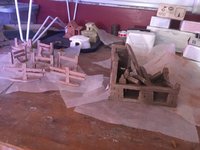@Kanorin - "Sedges have edges, and all sedges are cool", a quote from one of my prairie restoration nut friends. I'm not well versed in sedges. Genus Eleocharis is a sedge, and it is native to much of North America, it is quite likely winter hardy in Saint Louis area. In all probability the reason Eleocharis fails as an aquarium plant is that it is a full sun plant.
If you have an area that floods part of the year, or a permanent pond or swamp nearby, spend some time gazing at the grasses. You might notice "little grasses" that grow between the more robust grasses. The "little ones" are very likely to be sedges, genus Eleocharis, & Carex. Some might also be rushes, genus Juncus, some species of Juncus are quite dwarf.. It takes expertise beyond my skills to tell one species from another, but the size of the '"little grass" after August is a good clue to what the likely mature size will be.
Better than crawling around on hands and knees, is wandering through Timberwinds Nursery on Clarkson Road, Ellisville MO, just west of Ballwin. We have my parents "incarcerated" at a care facility in Ellisville. (just joking about incarcerated), I hit Timberwinds to regain some sanity after talking with mom, her dementia is fairly advanced. But she is in good shape for a 90 year old. Luckily Dad is as lucid as he was when he was in his 40's. He is also 90, and in excellent health. He does most of the care-taking for Mom. The graduated care facility is quite nice, providing adequate services without treating the residents like infants. They don't let Mom wander away, yet are invisible when Dad has her in tow taking her to my sister's or out for a restaurant or what ever he wants to do.
Tradewinds has a number of varieties of cotoneaster, you might find a better match than the one you deemed too small. They also have a very dwarf Thuja occidentalis, I believe it is 'Piccolo', at first glance it looks like a miniature Hinoki. But its foliage is even smaller than Hinoki 'Nana Gracilis' and it grows slightly faster than the Hinoki.. They have Hinoki too. Tradewinds has more bonsai worthy plants than most nurseries, I think someone on purchasing staff is a garden scale model railroading enthusiast.
Creating your scene is definitely more like model railroading, in that you must get scale to agree across all elements.
For grass, you are close to something between N scale and HO scale, moss would probably be best, the rush or sedges can be used to stand in for wheat or tall un-mowed grass.
For some reason I had forgotten about this resource. Prairie Moon Nursery. They feature Midwest native species for prairie restoration projects, but also for landscaping a back yard. They have an excellent selection of native sedges and rushes, also all manner of forbes (non-woody perenials) and also a fair number of woody shrubs and a handful of trees. Their shipping season is closed, but you can make plans for spring.

www.prairiemoon.com
@Carol 83 - if you have not gotten to Timberwinds, you should keep it on your "List of Places to Shop". I know it is a 30+ mile hike for you, but if you are doing one of the west Saint Louis County attractions, like Bush Farms or MOBot, you can make it a side trip.





